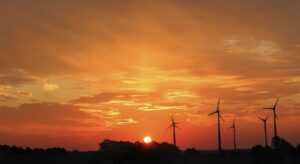Hydropower plants (HPPs) are very efficient sources of energy. They use renewable resources – the mechanical energy of falling water. The necessary water head is created by dams that are erected on rivers and canals.
Hydraulic plants allow to reduce transportation and save mineral fuel (about 0.4 tons of coal per 1 kWh). They are easy enough to operate and have a very high coefficient of efficiency (more than 80%). The prime cost of this type of plants is 5…6 times lower, than that of thermal power plants, and they require much less personnel.
Location of HPPs largely depends on natural conditions, such as the nature and regime of the river. The scheme of hydropower plants is shown in Fig. 3. High-pressure hydroelectric plants are usually built in mountainous areas, and plants with a lower head but a higher flow rate are in operation on lowland rivers.
To create the head across the river channel, a dam is built to accumulate water in the reservoir and concentrate the difference in water level in a relatively small area (across the width of the dam). As a rule, directly adjacent to the dam is the HPP building, which houses the main equipment – hydraulic units (in the machine building) and devices for automatic control and management of HPP operation.
Water is supplied to the hydraulic turbines via pressure water pipelines. Rotation of the hydraulic turbine impeller under the pressure of falling water is transmitted to the shaft of the hydrogenerator, which generates electric current. In the open area next to the HPP building or in a separate building usually construct a HPP step-up transformer substation with switchgear.
HPPs are the second most important power plants after thermal power plants. In their work they use the energy of water converted into electric current, which is a renewable resource. The simple operation of such plants does not require a large number of personnel. The efficiency factor is up to 85%.
Electricity produced by hydroelectric power plants is considered the cheapest, its price is about 5-6 times less than that of thermal power plants. Hydropower plants are highly maneuverable and can be put into operation within 3-5 minutes, whereas at thermal power plants it takes several hours. This quality is especially important when covering peak loads in the daily power supply schedule.
The main disadvantages of such structures are:
- Significant capital investments for their construction.
- Binding to a certain territory or area with hydro resources.
- In the process of construction vast areas are flooded, large agricultural areas are withdrawn from use, damage is caused to fisheries, the ecological balance is disturbed.
- The full capacity of the power plant is realized only during certain times of the year, during the period of maximum rise of water.


